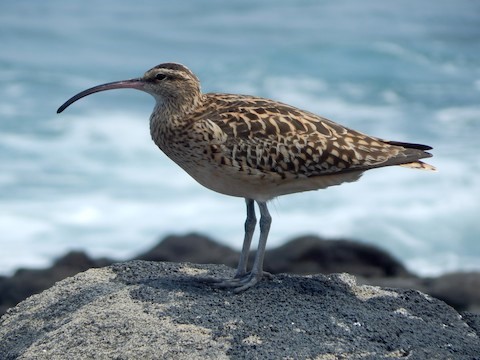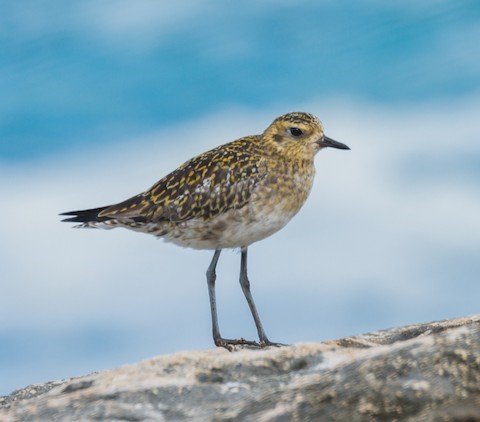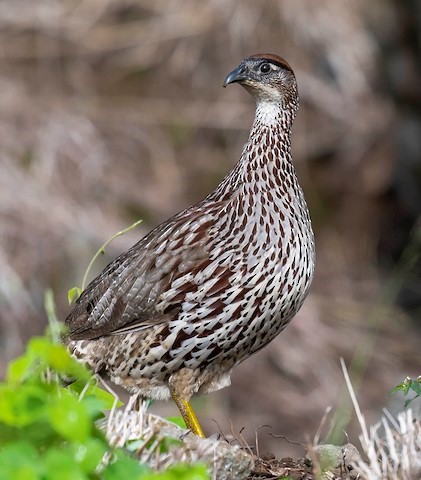South Point, Big Island, Hawaii

The southernmost piece of solid ground in the fifty states is a barren, windswept headland facing thousands of miles of open ocean. Travelers of the Mamalahoa Highway are drawn to it. Those who reach the point are likely to find Pacific Golden-Plover, Wedge-tailed Shearwater, “Hawaiian Noddy”, and Eurasian Skylark. A well-timed visit might yield Bristle-thighed Curlew or unusual seabirds. Inland along the highway nearby are a few trails where Erckel’s Francolin, Hawaiian Hawk, Hawaii Elepaio, Red-billed Leiothrix, Apapane, and Common Amakihi can be found.
Orientation
Directions
South Point is at the southern tip of the Big Island, about an hour-and-a-half’s drive (70 miles) south of Kailua-Kona and an hour and 45 minutes (80 miles) southwest of Hilo.
From Kona International Airport. Take Route 19 south and remain on it for 60.3 miles—its number changes from 19 to 11 and it becomes the Mamalahoa Highway—then turn south onto South Point Road and go 10.8 miles to its end.
From Hilo International Airport. Turn left (south) onto Kanoelehua Avenue (which is also Route 11 and the local segment of the Hawaii Belt Road), go 64.9 miles, turn left (south) onto Kamaoa Road. After 4.0 miles turn left onto South Point Road and go 9.0 miles to its end.
Birdfinding
The southern portion of the Big Island is accessed by the Mamalahoa Highway, which is the main route between Kailua-Kona and the eastern side of the island, including Hawaii Volcanoes National Park and Hilo. The 11-mile detour to South Point is a well-known geographical attraction, and there are other stops beside the highway for a walk or picnic to break up the drive.
South Point. South Point ends up on many itineraries mainly because of its strategic location on the map. Being honest, most visitors are probably somewhat disappointed by the experience—not bad, but not great either. Those who make the trip especially for the birds should set their diversity expectations toward the low end of the scale.

On the landward side, the grassy heath often produces Pacific Golden-Plover, Eurasian Skylark (sometimes in numbers), and sometimes flocks of introduced waxbills, Yellow-fronted Canary, or Saffron Finch. Bristle-thighed Curlew has been most found most often in August and September. The rocky shoreline is good for Wandering Tattler and Ruddy Turnstone, and sometimes a rarity such as the Inca Tern that showed up in March 2021.
Considering its prominence as a seaward projection, South Point is mediocre for seabirds. Most often seen are Yellow-billed Tropicbird, Wedge-tailed Shearwater, Great Frigatebird, Brown Booby, and “Hawaiian Noddy”. Apart from the shearwater, several more tubenose species have been reported sporadically: Laysan and Black-footed Albatrosses, Hawaiian Petrel, and Sooty Shearwater. There have also been isolated reports of Juan Fernández and Bulwer’s Petrels.
Manuka State Wayside Park. A roadside stop along the Mamalahoa Highway between Kealakekua Bay and South Point, Manuka Wayside has a picnic area, an arboretum, and a 2-mile nature trail that loops through a tract of native forest. The trail is notably consistent for Hawaii Elepaio and Red-billed Leiothrix, as well the more expected Apapane and Common Amakihi.
Hawaii Volcanoes National Park, Kahuku Unit. Just west of the South Point junction, a side-road on the opposite side leads into the interior of the island onto the decommissioned Kahuku Ranch—which has been incorporated into Hawaii Volcanoes National Park. Driving up this road leads to a series of picnic areas and trailheads: (1) Pu’u o Lokuana Cinder Cone, 0.4-mile loop; (2) Pu’u o Lokuana Trail, 2.0-mile loop; (3) Kamakapa’a Trail, 0.5-mile loop; (4) Palm Trail, 2.6-mile loop; (5) Pali o Ka’eo Trail, 2.1-mile loop; and (6) Pit Crater Trail, 2.4 miles each way with an elevation gain of 1,165 feet.
Birds often seen in the Kahuku Unit include: Erckel’s Francolin, Hawaiian Hawk, Apapane, and Common Amakihi. Others present but seen less often include Kalij Pheasant, Hawaii Elepaio, Oma’o, Red-billed Leiothrix, and I’iwi.
(Note: The Pit Crater Trail and more distant side-trails approach the boundary of the remote Ka’u Forest Reserve, which has remnant populations of three range-restricted Big Island endemic honeycreepers—Akiapola’au, Hawaii Creeper, and Hawaii Akepa—but the reserve is very large and these trails do not give access to any area where any of these species has been reported in modern times.)
Whittington Beach Park. A roadside stop along the Mamalahoa Highway between South Point and Volcano, Whittington Beach provides access to the shoreline and a small lagoon that often has a few waterfowl, shorebirds, and Black-crowned Night-Heron. “Hawaiian Noddy” and Yellow-billed Tropicbird can often be seen over the ocean a short distance from shore. A few of the common species of introduced finches frequent the bushes and fields around the lagoon.
Services
Accommodations
Hotels are numerous along the Kona Coast. There are also a few in the South Point area, including:
Big Island Bed & Breakfast, 1-808-785-6456
Sea Mountain, 1-808-928-6200
Notes
Links



